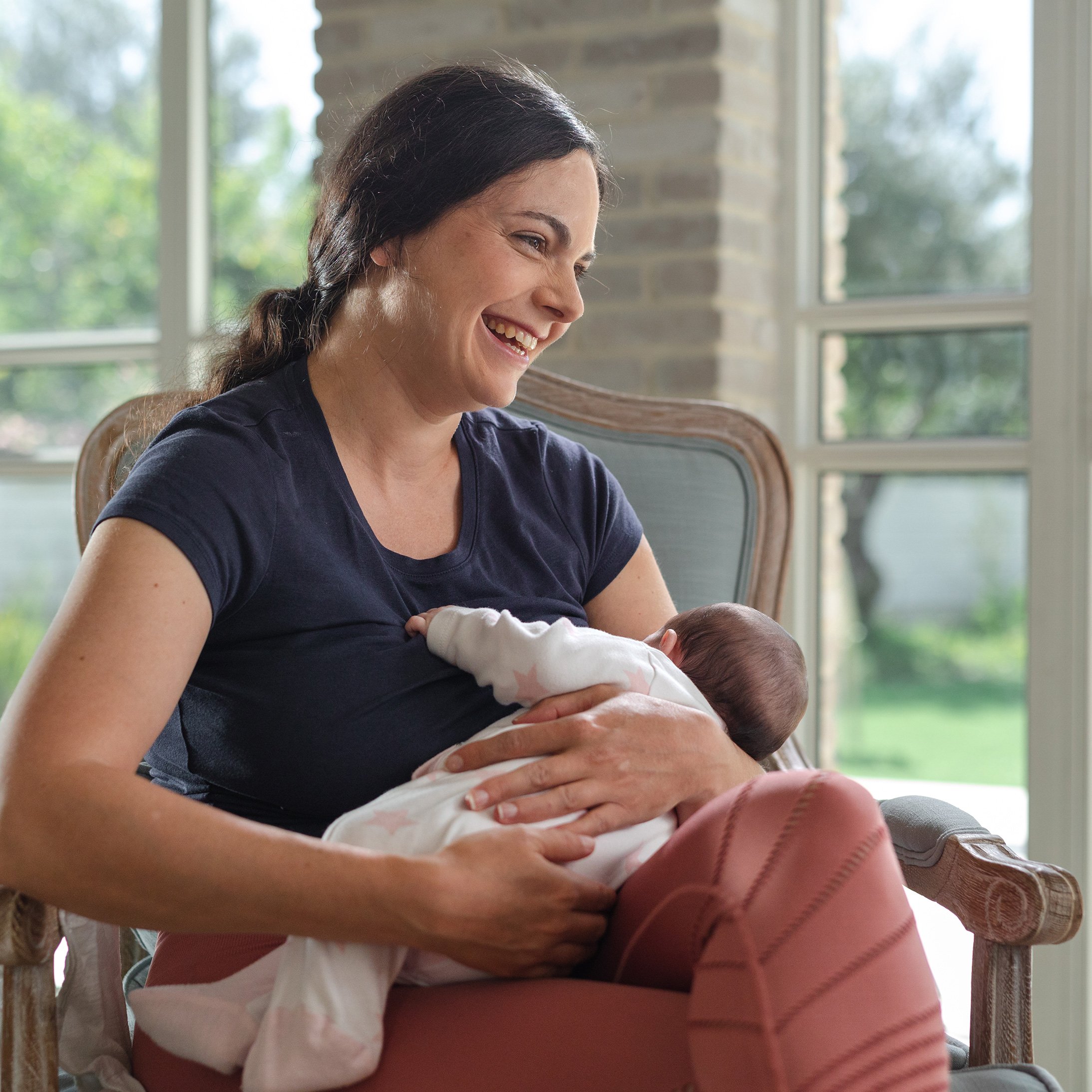Best Breastfeeding Positions for Mom & Baby
Breastfeeding is perhaps the most loving and vital thing a mother can do with her baby, but it may also have its challenges. One of the most frequent problems that most new mothers encounter is pain while breastfeeding. Most often, the secret to a more comfortable and successful breastfeeding session is correct positioning. Not only do the proper breastfeeding positions assist in minimizing soreness and avoiding nipple damage, but they also help ensure that your baby is receiving adequate milk. In this article, we'll discuss some different nursing positions for breastfeeding that can assist in increasing comfort and increasing milk transfer for you and your baby.

Top Breastfeeding Positions
Finding a comfy position while nursing can make a huge difference—for both you and your baby. Some positions work better than others depending on your baby's needs or how you're feeling post-birth. Here are a few tried-and-true favorites:
1. Cradle Hold
This one’s the classic, and probably the first position that comes to mind. Your baby’s head rests in the crook of your arm while their body lies across your chest. It’s great for full-term babies who already have some head and neck control.
- Why moms love it: It feels natural and cozy, and it’s great for bonding.
- What to watch out for: If your baby’s having a hard time latching deeply, this position might not offer the best support early on.
2. Cross-Cradle Hold
Think of this as the cradle hold’s more supportive cousin. You’ll hold your baby with the arm opposite the breast you’re feeding from, giving you more control over their head and helping guide them into a good latch.
- Why it’s helpful: It's especially useful for newborns or babies who are still figuring out how to latch. You’ve got a bit more control to help guide them in.
- Keep in mind: It does require a bit more coordination and might not be the easiest right after a C-section if you're sore or healing.
3. Football Hold (aka Clutch Hold)
In this position, your baby is tucked under your arm like a little football, with their body along your side and their head at your breast. It's super helpful if you’ve had a C-section or if you’ve got larger breasts.
- Why it works: Keeps pressure off your belly (huge win after a C-section!) and gives you a clear view to see how your baby is latching.
- Heads-up: You’ll probably want some pillows to prop things up and make it comfier for your arm and baby.
4. Side-Lying Position
This one’s a favorite for those late-night feeds when you just want to stay comfy in bed. You and your baby lie on your sides facing each other, and the baby latches on while you both stay nice and cozy.
- Why it’s great: It’s perfect for nighttime feedings and gives your back a break, especially helpful if you’re dealing with any post-birth aches and pains.
- Something to note: It can take a bit of practice to get a good latch in this position, especially with tiny newborns. But once you get the hang of it, it’s a total game-changer.
5. Laid-Back (Biological Nurturing) Position
This is the most relaxed of the bunch. You lean back comfortably (not totally flat) and let your baby lay tummy-to-tummy on your chest. This position taps into your baby’s instincts to find the breast and latch on.
- Why it works: It’s super calming for both of you, great for bonding, and often helps reduce nipple pain. Plus, gravity’s on your side here, which can make latching a little easier.
- Just a heads-up: Some moms find it tricky to get the right angle or positioning at first, and not every baby takes to it right away, but it’s worth trying, especially in the early weeks.
Advantages of Correct Breastfeeding Positions
Why Getting the Right Breastfeeding Position Matters
Finding the right position when nursing isn’t just about comfort, it can make a huge difference for both you and your baby. Here’s why good positioning is worth figuring out:
1. Say Goodbye to Sore Nipples
Nipple pain is one of the most common struggles when starting out. And in many cases, it comes down to how your baby is latching. A good breastfeeding position helps your baby latch on deeper (more of the areola, not just the tip), which takes the pressure off and helps avoid soreness, cracks, or even infections.
2. Helps Baby Get More Milk
When your baby is in the right spot and latched on well, they’re able to drink more easily. If the latch is too shallow or the angle’s off, it can be hard for them to get enough milk, which can lead to frustration and less-effective feeds. Good positioning ensures your baby can feed comfortably and get what they need.
3. Boosts Bonding Time
Nursing isn’t just about food, it’s also a time to connect. Snuggling close during a feed, especially with skin-to-skin contact, strengthens that bond between you and your baby. When you're both comfy, it's easier to focus on each other and enjoy the moment.
Getting Set Up for Breastfeeding
Before you even start feeding, a little prep can go a long way in making things smoother and more enjoyable. Here are a few things that help:
Supportive Pillows
Use pillows to support your arms, back, or even your baby. A good nursing pillow can be a total game-changer, it lifts the baby up to the right height and keeps you from hunching over, which is huge when you’re still healing post-birth.
Keep the Room Calm and Quiet
Try feeding in a peaceful spot, somewhere that’s quiet and free from distractions. A calm environment helps both you and your baby stay focused and relaxed during feeds.
Find a Comfy Chair
A supportive chair or sofa makes a big difference. Something with armrests is ideal so you can prop up your elbows and relax your shoulders while feeding. You’ll likely spend a lot of time here in those early weeks, so make it a space you love.
Have Everything You Need Close
To make breastfeeding more comfortable and convenient, have all supplies within reach, including burp cloths, food, and even your phone. Above all, keep a glass of water nearby, as staying hydrated is important for a healthy milk production.
Real-Life Tips to Make Breastfeeding Easier
Breastfeeding can be a beautiful bonding experience, but let’s be honest, it’s not always easy right out of the gate. Here are a few tried-and-true tips that can really make a difference:
Get That Deep Latch
When your baby latches, you want them to get a good mouthful, not just the nipple. A deep latch means their mouth covers more of the bottom part of the areola (that darker area around the nipple). This helps them get more milk and keeps things way more comfortable for you.
Check Baby’s Chin
Your baby’s chin should be tucked in, right up against your breast. It helps line things up just right for a better latch and smoother milk flow, and it’s a big help in avoiding sore nipples.
Use a Pillow for Backup
A nursing pillow (or a regular pillow or even your pregnancy pillow) can be a lifesaver. It props your baby up to the right height, so you’re not straining your arms or shoulders, especially helpful if your back’s still feeling sore after pregnancy.
Take a Breath and Relax
The early days can feel overwhelming, especially if things aren’t going smoothly. Try to get comfy, find a calm spot, and give yourself some grace. It takes time, and that’s okay.
Common Breastfeeding Hiccups and How to Handle Them
Even though breastfeeding has a ton of benefits, it’s normal to hit a few bumps along the way. Here’s how to handle some of the most common ones:
Trouble with Latching?
If your baby isn’t latching well, try adjusting their position or use the cross-cradle hold, it gives you more control over their head and helps guide them in. Still stuck? visit from a lactation consultant can work wonders.
Ouch, Nipple Pain?
Painful nipples are often a sign of a shallow latch. Make sure your baby’s taking in more than just the tip of the nipple. And don’t forget about nipple cream, it can seriously help with soreness in those early days.
Feeling Overfull (Engorgement)?
If your breasts are feeling full and uncomfortable, try using a warm compress, a lactation massager, or gently hand-expressing a bit of milk before feeding. It’ll take the edge off and make it easier for your baby to latch.
When to Seek Professional Help
Sometimes breastfeeding just doesn’t go as smoothly as we hoped, and that’s okay. If you’re running into ongoing issues, don’t wait to reach out. Getting help early can make a huge difference. Here are a few signs it might be time to talk to a pro:
Your Nipples Are Hurting
A little tenderness is normal at first, but if the pain sticks around, gets worse, or you’re dealing with cracks or bleeding, it’s time to call in a lactation consultant. They can help figure out what’s going on and get you some relief.
You’re Worried About Milk Supply
If your baby doesn’t seem full after feeding or you’re constantly wondering if they’re getting enough, trust your gut and talk to someone. A lactation expert can check in with you and help make sure everything’s on track.
You’re Struggling After a C-Section
Breastfeeding after surgery can be tricky, especially if you’re sore or limited in how you can sit or hold your baby. A lactation consultant or physical therapist can help you find positions that are both comfy and healing-friendly.
Conclusion
Breastfeeding isn’t one-size-fits-all, and neither are the positions. Whether you’re going with the classic cradle hold, trying the football hold for more support, or kicking back with the laid-back position, the key is finding what feels good for you and your baby.
It might take a little trial and error, and that’s normal. What works for one mom-baby duo might not work for another, and that’s okay. Once you find your groove, breastfeeding becomes a lot more comfortable and way more enjoyable for both of you.
And if things aren’t clicking or you’re feeling unsure, don’t hesitate to reach out for help. A lactation consultant or healthcare provider can walk you through it and help you figure out what’s best for your body and your baby.
FAQs
What’s the best breastfeeding position for a newborn?
The cross-cradle hold is a great starting point. It gives you more control over your baby’s head and helps guide them into a good latch, which is especially helpful in those early days.
How can I avoid back pain while breastfeeding?
Good posture goes a long way! Sit somewhere comfy, use a nursing pillow for support, and try positions like side-lying or laid-back to take pressure off your back, especially helpful if you're still healing post-birth.
Do I need a pillow for breastfeeding?
You don’t have to have one, but a nursing pillow can make a big difference. It helps bring your baby to the right height so you're not straining your arms, shoulders, or back during feeds.
How do I know if my baby’s latched on properly?
A good latch means your baby’s mouth covers more than just the nipple, it should include a big part of the areola too. Their lips should be flanged out (kind of like a fish), and feeding shouldn’t hurt. If you're feeling sharp pain, it might be worth checking in with a lactation pro.

